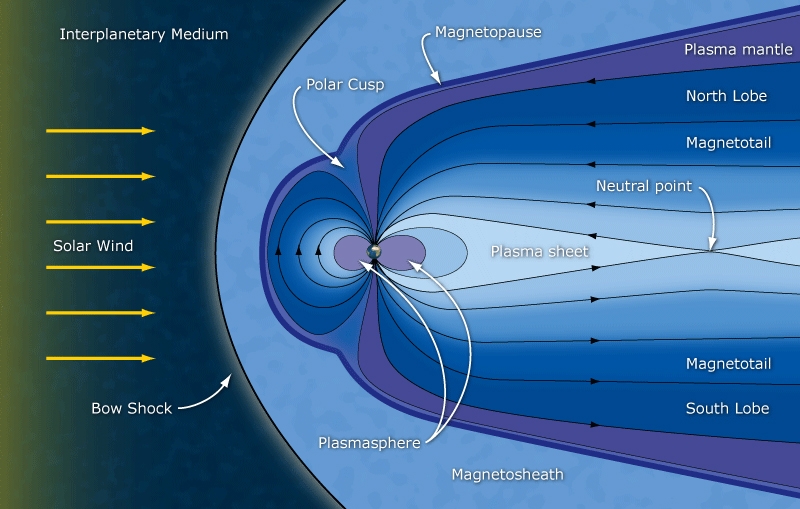 The solar winds blow, shaping earth’s magnetic field. What happens on the moon when it encounters the magnetotail? Can dust storms on the moon be affected by earth’s magnetic field?
The solar winds blow, shaping earth’s magnetic field. What happens on the moon when it encounters the magnetotail? Can dust storms on the moon be affected by earth’s magnetic field?
Apples and Oranges
The earth’s magnetic field receives constant bombardment from the sun’s solar wind. This forces back the flux lines into a long extended tail on the side of earth opposite the sun. This extended stream is referred to as a magnetotail.
The Moon’s Time of the Month
Most of the month the moon is not under the influence of earth’s magnetotail, but is exposed to the solar wind. Yet, part of each month the moon does cross into earth’s magnetotail. This occurs over a period of about six days, three days before the moon enters its full phase until about six days later. The moon probably experiences strange effects from this, since the magnetotail harbors perhaps ten times as many plasma particles as the solar wind carries. Among these is an abundance of electrons.
The Dark Side – Dust Storms on the Moon
The electrons charge the moon’s surface. This is especially so on the dark side, as there is no light to dampen electron excitations there. The electrostatic charge could cause dust to be stirred up to produce clouds.
Due to the electrical charge gradient, any dust clouds would likely be drawn in the direction of the moon’s bright side. This could cause difficulties for astronauts and astronomical equipment if any were present. This would be particularly so at the interface of the dark and bright sides.
The certainty of these events has not yet been determined, since past mission astronauts were not on the moon during such run-ins with the magnetotail.
The moon has a magnetic field of its own, though not nearly so strong as earth’s. Its magnetic field is a surface one, which could interact in a complex variety of ways with the charged particles.
Laboratory in Space
In view of all these facts, K.K. Khurana and others, including Jasper Halekas, have recommended NASA, during its Artemis mission scheduled for 2011, completely exploit the “field and plasma measurement capabilities of Artemis” that other future space missions will lack” in studying the physics of the moon’s interior and exterior. Artemis stands for “Acceleration, Reconnection, Turbulence, and Electrodynamics of Moon’s Interaction with the Sun.”
Note: You might also enjoy Characteristics of a High Mass Star
References:
- The Moon and the Magnetotail
- The Full Moon’s Passage Through Earth’s Magnetotail
- Solar wind and terrestrial magnetospheric plasma interactions with the moon
- Lunar Science with ARTEMIS: A Journey from the Moon’s Exosphere to its Core
← Back to Classic Science
← Home

So glad that there are smart people like you to understand stuff like this and better yet, able to explain to the common man!
The image….just where would the Moon be? If we consider the Earth 8000 miles and the moon 239,000 miles, it would be completely OFF this image…… What part of the magneto-tail is the moon interacting with?
The Artemis mission is scheduled for 2024? Not 2011? I wonder what a moon dust storm would be like? There is no wind on the moon and you said the dust would move due to an electrical charge gradient. I wonder if the solar “wind” would have an effect in moving it?
Here is an interesting reference to the year 2011… https://solarsystem.nasa.gov/missions/artemis/in-depth/ As to the solar wind, it doubtless exerts an influence, but it is considered much less a factor do to a much higher concentration of plasma particles in Earth’s magnetotail.